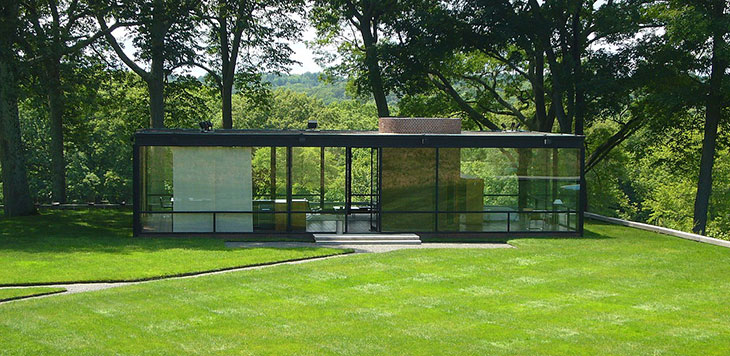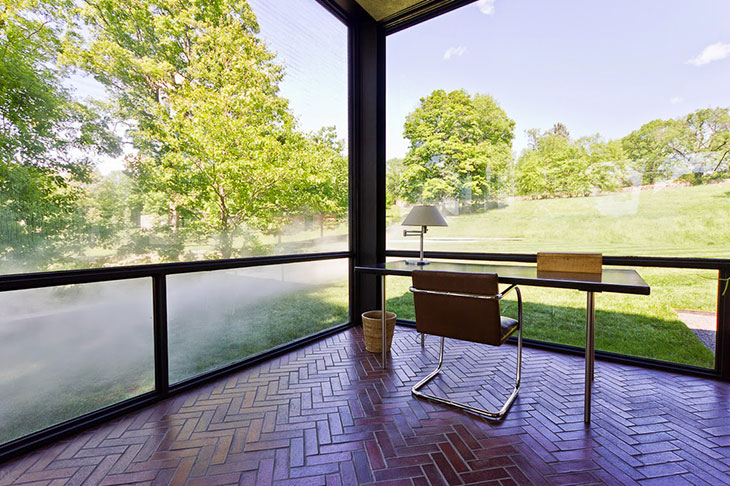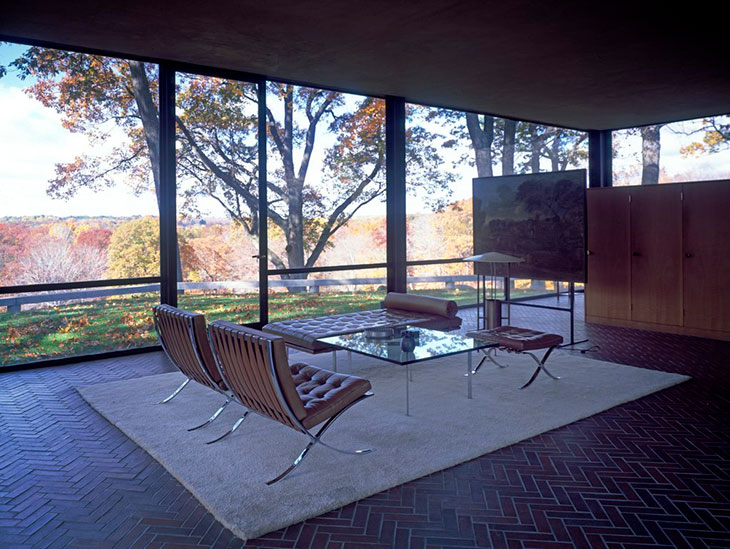
Located amidst the lush landscapes of New Canaan, Connecticut, the Glass House, designed by Philip Johnson, is a prime example of modernist architecture. Built in 1949, this iconic structure embodies a radical shift in architectural thought and practice. Johnson, who lived in the house until his death in 2005, utilized glass walls and an open plan to dissolve the boundaries between interior and exterior, fostering a seamless interaction with the surrounding nature. This design was ahead of its time in terms of aesthetic and material use, as well as its philosophical implications about how space is inhabited and experienced.
ARCHITECTURAL
LANDMARKS
The Glass House’s enduring relevance is rooted in its visionary design which continues to inspire architects and designers globally. It serves as a crucial point of reference for discussions about transparency, simplicity, and the integration of the natural environment into architectural design. Furthermore, its role as a cultural hub, hosting gatherings of prominent artists, thinkers, and architects, adds depth to its significance as a site of intellectual exchange. As we continue to explore and appreciate Johnson’s architectural innovations, the Glass House remains a vibrant testament to the possibilities of modern design and a beacon of inspiration for the future of architecture.

The Genesis of the Glass House
Philip Johnson, a key figure in 20th-century architecture, embarked on the design of the Glass House at a time when he was transitioning from his role as a curator at the Museum of Modern Art in New York to practicing architecture. The house was his first commissioned project and served as his residence for 58 years. It drew heavily from the principles of his mentor and friend, Ludwig Mies van der Rohe, particularly from Mies’ design for the Farnsworth House, which shares the Glass House’s minimal structure, industrial materials, and expansive use of glass.
However, Johnson’s design was not merely an imitation but an evolution. The Glass House’s perfectly symmetrical, rectangular form and its seamless integration with the surrounding landscape set it apart. Its exterior walls are made entirely of glass with no interior walls, aside from a cylindrical brick structure that houses the bathroom. The transparency of the house dissolves the boundaries between interior and exterior, creating an ongoing dialogue with its environment.
Architectural and Philosophical Significance
The Glass House is often seen as a bold embodiment of Modernism’s core tenets: simplicity, clarity of form, and the honest expression of structure. Unlike traditional homes, it lacks decorative ornamentation, with Johnson emphasizing the idea that “less is more.” This minimalist approach was revolutionary at the time and challenged conventional notions of privacy and domesticity.
Philosophically, Johnson’s house proposes a radical transparency that goes beyond physical materials to suggest a way of living that is fully integrated with nature and devoid of unnecessary barriers. The Glass House functions as a living exhibit, continually reflecting the changes in its surroundings and the passage of time, which Johnson believed was the essence of true beauty in architecture.
The Glass House as a
Cultural and Architectural Artifact
The Glass House has not only been Johnson’s residence but also a gathering place for leading intellectuals, artists, and architects. It has hosted figures like Andy Warhol, Frank Stella, and Robert Rauschenberg, acting as a crucible for creative exchange. This cultural dimension adds layers to its significance, serving as a physical manifesto of Johnson’s beliefs and a hub for intellectual discourse.
Moreover, the Glass House’s influence on residential architecture is profound. It challenged and changed the architectural possibilities for domestic spaces, inspiring a generation of architects to explore transparency, open plans, and the relationship between built forms and their environments. It paved the way for the development of new materials and construction techniques that supported large, uninterrupted expanses of glass.
Preservation and Continuing Relevance
Today, the Glass House is preserved as a National Trust Historic Site. It is open to the public, offering a firsthand view of Johnson’s vision and its place in architectural history. The ongoing interest in the Glass House can be attributed to its timeless nature. Unlike many structures that age and feel increasingly irrelevant, the Glass House remains a pertinent example of how architecture can transcend time through purity of design and philosophical depth.
The principles it champions—transparency, simplicity, and harmony with nature—are increasingly relevant in today’s architecture, where sustainability and integration with the environment are paramount. Its preservation allows it to serve as a continuous source of inspiration and education for both current and future generations of architects and designers.

Philip Johnson’s Glass House is a profound exploration of the possibilities of modernist architecture. Its ongoing relevance lies in its ability to challenge, inspire, and evolve with the times. As we continue to discuss this architectural marvel, it remains a clear, though invisible, force in the dialogue about what architecture was, is, and could be. Through its simplicity and transparency, the Glass House challenges us to think about space, structure, and society in radically open ways, maintaining its place as a cornerstone of modern architectural thought.



